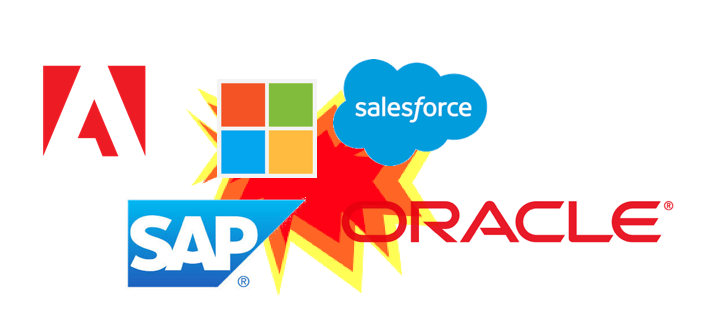
by twieberneit | Aug 28, 2018 | Analysis, Blog |
A little recap As it has been some time since I published Clash of Titans – Platform Play, the first part of this little series, let me start with a little recap. The business applications market, especially the CRM market, is evolving fast. CRM has morphed from concentrating on transactions to become an enabler of engagements. Engagements in turn result in experiences. And positive experiences are what companies want to achieve. In a digital world this is possible only if companies rely on a foundation, a (technical) platform. Becoming the provider of the dominant technical platform therefore has become the main goal of of the big business software vendors. However, even governing a great technical platform is not enough. Software vendors that want to be successful platform players need to be able to deliver on four areas to succeed: Platform (IaaS/PaaS) Ecosystem Insight Productivity Only if they deliver on all four aspects are ‘platform players’ able to provide their customers with what they need to involve themselves in digital engagements that result in sustainably positive experiences. I will look at how the big four are measuring up in this and the next article of this little series. Microsoft and SAP will be the starters. Then I will look at Oracle and Salesforce. I might conclude with some surprise additions. But let the games begin! Microsoft Microsoft is the (not so, if you look sharply) hidden champion of this game. Actually, I think that Microsoft is the 800 pound gorilla in this game. It is Microsoft’s objective to become the fabric that connects enterprises of all sizes with their stakeholders,...

by twieberneit | Aug 14, 2018 | Analysis, Blog |
A lot has evolved since my Clash of the Titans post that looked into how the big 4.5 (Microsoft, Oracle, Salesforce, SAP, and Adobe) and others are positioning themselves and their platform in the greater CRM arena. First, the commoditization of the business application has accelerated and the vendors’ focus on the underlying platform has increased. CRM, and enterprise software in general, has always been a platform play although this has not always been recognized and sometimes even negated. The obvious reason for it being a platform play is that the creation of positive customer and user experiences need a consistent technical platform. Or else we are ending up in engagements that are fragmented across interactions. This results in inconsistent and poor experiences. So far, so well known. A bit less obvious is the fact that there will be only few dominant platforms. Vendors, who want to become and stay successful on a grand scale need to be one of these few platform providers and attract partners and customers. This is the reason why I consult my customers that one of the very first IT strategy decisions that they need to take is the platform decision. As the article got a little longer this time and as I do not tend to write articles that are as long as dear friend Paull Greenberg’s (maybe I should consider to?) this revisit of the Clash of the Titans will become a two or three piece series, first covering the framework I want to use, the very definition of what I talk of when saying that CRM is a ‘platform play’. The...

by twieberneit | Mar 9, 2018 | Analysis, Blog |
The News A few days ago Salesforce announced an update to its sales cloud that features Einstein powered predictions, insights, and productivity. The press release is linked above or alternatively you can read it below, along with some comments of mine. Salesforce is (again) addressing the three main issues that plague CRM implementations since Tom Siebel coined this term. Let me paraphrase them> Salespeople do not find the time to do their job, which is selling. Instead they are spending an inordinate amount of time entering data that supposedly only helps their management controlling them a little more. Sales managers do not have enough visibility into what is going on in their area of responsibility, what their team is doing (and why), whether they are doing the right thing. The same problem, of course, applies to the Head of Sales, just at a bigger scale. Sales operations is charged with creating meaningful reports that tell the one single truth. This they need to do using data that resides somewhere, data that is distributed, instead of some central consolidated place. Data that is essentially not fully trustworthy. Salesforce is doing this using a triple of features: The Salesforce resident AI: Einstein to help sales persons identify the most promising opportunities to work upon The Salesforce Inbox that increases productivity by attributing emails to the right accounts as well as connecting to the calendar Sales Analytics to help salespeople and their management to visualize, interpret, and use the available data The Press Release Ask any rep what their favorite part of the day is, and chances are that their answers...

by twieberneit | Feb 12, 2018 | Blog |
In all likelihood you know that CPQ stands for Configure, Price, Quote. CPQ software helps mainly B2B companies to more efficiently sell highly configurable products. As the name suggests, the software helps sales people during the three steps of configuring the product, getting and agreeing a price for it, and finally initiating the quotation process. The more variables, or parts, a final product has the more advantage a CPQ tool offers to both, sellers and buyers. It is geared for streamlining and accelerating the sales process while reducing errors. A CPQ system typically ties into CRM- and ERP systems and, apart from being made available to channel partners, is often also exposed through an e-commerce system (have you ever configured your car online?). CPQ currently being a hot topic (and not only since the planned acquisition of CallidusCloud by SAP) there is a good number of companies offering this functionality. But in many scenarios CPQ also needs a CLM. Now I hear you asking: what is CLM? After all there are many possible long terms for this abbreviation. Why does it connect to CPQ? And why does this combination make an appearance in a blog that distinctly focuses on CRM, customer engagement and ultimately an improved customer experience? Starting from the end: CPQ, and by extension CLM, is more and more becoming a link between the front office and the back office and therefore has considerable impact on the customer engagement process, and hence influences the customer experience. So, what is CLM? CLM is an abbreviation for Contract Lifecycle Management. As such it deals with the creation of contracts,...

by twieberneit | Feb 7, 2018 | Blog |
The most important tool that enterprise software vendors have in their respective arsenals is their platform. While Vinnie Mirchandani rightfully states that Enterprise Software Platforms have so far underwhelmed, Denis Pombriant proclaims them the new battleground. In my opinion it is not that new a battleground but as part of the Clash of Titans it is becoming more evident as a battleground. An enterprise software platform was always part of the battle for dominance in the customer engagement – or putting it into (marketing) industry lingo – customer experience market. It is actually an integral part of it. This is largely because of the ongoing commoditization of transactional business applications. But it was sexier to talk about shiny topics like engagement and experience than to talk about the grease and the machinery behind that drives and enables the technical delivery of engagements – note, that there are systems of engagement, but there is nothing like a system of experience. And now topics like chatbots, machine learning, AI, ambient computing, IoT, to name a few, made the machinery – the platform – the new black. A – perhaps not so – brief history When looking at the broad topic of CRM, customer engagement or customer experience, we have seen a lot of change happening since the early days of Sales Force Automation, SFA. Back in the early 90s one of the first topics has been SFA, with a focus on making a distributed sales force more effective and efficient. Contact management came even earlier, call center software and field service quickly followed. The emerging industry was dominated by little players...





